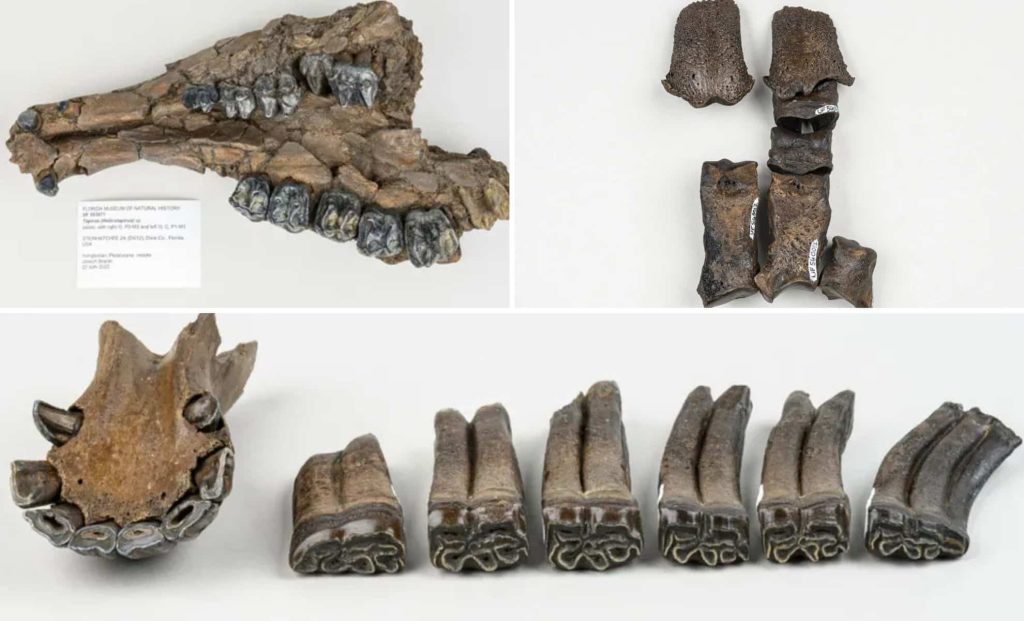Scientists Stunned by 500,000-Year-Old Fossil Find in Florida Sinkhole – Indian Defence Review

Divers exploring Florida’s Steinhatchee River have uncovered a stunning fossil site, revealing remains buried for hundreds of thousands of years in an ancient sinkhole. What began as a routine expedition quickly turned into a groundbreaking discovery, drawing the attention of researchers eager to understand its significance. A stunning prehistoric fossil site has been uncovered in Florida’s Steinhatchee River, revealing a 500,000-year-old Ice Age graveyard hidden beneath the water. This extraordinary discovery has yielded over 500 fossils, including remains of giant armadillos, ancient horses, sloths, and possibly a previously unknown species of tapir. The site, once a prehistoric sinkhole, served as a natural trap for animals during the Irvingtonian North American Land Mammal Age (1.6 million–250,000 years ago).The fossils, remarkably well-preserved, provide an unprecedented glimpse into the evolutionary changes of species that roamed North America during a time when fossil records are scarce. This find has the potential to reshape scientific understanding of faunal transitions and ecosystem changes during the Ice Age.Underwater fossil sites are rare, but a newly uncovered 500,000-year-old sinkhole in Florida’s Steinhatchee River is proving to be a goldmine of Ice Age fossils. A scientific study published in the journal Fossil Studies details how fossil collectors Robert Sinibaldi and Joseph Branin first discovered the site in 2022 while diving in the river. What initially seemed like isolated teeth and bones soon revealed itself to be a remarkably well-preserved fossil deposit, leading the Florida Museum of Natural History to launch a full-scale excavation to investigate its significance.According to Sinibaldi, the sheer number and condition of the fossils immediately stood out:“It wasn’t just quantity, it was quality. We knew we had an important site, but we didn’t know how important.”Since then, experts at the Florida Museum of Natural History have been meticulously analyzing the fossils, aiming to reconstruct the prehistoric environment that once thrived in this region during the Ice Age.Among the most intriguing finds at the site are fossils from an extinct giant armadillo-like species called Holmesina. Scientists have long known that a size increase occurred within this genus over time, transitioning from Holmesina floridanus (which weighed about 150 pounds) to Holmesina septentrionalis (which reached up to 475 pounds). However, fossil evidence documenting this transition has been lacking—until now.Rachel Narducci, vertebrate paleontology collections manager at the Florida Museum, emphasized how these fossils provide crucial evidence of this evolutionary shift:“It’s essentially the same animal, but through time it got so much bigger and the bones changed enough that researchers published it as a different species.”The discovery of ankle and foot bones from Holmesina has revealed that the animal’s size increased before its anatomy fully adapted, offering a rare snapshot of how gradual changes in evolution occur.“This gave us more clues into the fact that the anatomy kind of trailed behind the size increase. So they got bigger before the shape of their bones changed.”This insight challenges traditional assumptions that anatomical changes and size evolution occur simultaneously, showing that species can grow larger before their skeletal structures fully catch up.One of the most exciting aspects of the discovery is a skull from an ancient tapir, a pig-like mammal with a short elephant-like trunk. This fossil presents features that have never been recorded before, raising the possibility that it could belong to a previously unknown species.However, Richard Hulbert, the study’s lead author, cautions against making definitive claims too soon:“We need more of the skeleton to firmly figure out what’s going on with this tapir. It might be a new species. Or it always could just be that you picked up the oddball individual of the population.”This means further excavations and analysis are needed before scientists can confirm whether this tapir represents a distinct species or is simply an unusual variation of a known one.Among the 552 fossils recovered, approximately 75% belonged to an early species of caballine horses, which are ancestors of modern domestic horses. The presence of such a large number of horse fossils suggests that Florida’s landscape 500,000 years ago looked very different from today.“For the first time, we had individuals that were complete enough to show us upper teeth, lower teeth, and the front incisors of the same individual,” said Hulbert, highlighting the exceptional condition of the fossils.These well-preserved horse teeth could allow scientists to study the diet and ecology of Ice Age horses in unprecedented detail, helping reconstruct the ancient ecosystems in which they thrived.The abundance of horse fossils suggests that Florida’s Big Bend region, which is densely forested today, may have once been a vast, open grassland, more suitable for large herbivores. This discovery provides important clues about prehistoric climate change and habitat shifts, helping researchers understand how ecosystems transformed over thousands of years.Comment Save my name, email, and website in this browser for the next time I comment.
© 2024 | Indian Defence Review | All rights reserved
Source: https://indiandefencereview.com/500000-year-old-fossil-find-florida/



